Apeldoorn 作者: 来源: 发布时间:2021-06-29
I. Population and Area
Location in Gelderland
Coordinates: 52°13′N 5°58′E
Country Netherlands
Province Gelderland
Area
• Municipality 341.15 km2 (131.72 sq mi)
• Land 339.91 km2 (131.24 sq mi)
• Water 1.24 km2 (0.48 sq mi)
Elevation 16 m (52 ft)
Population (Municipality, January 2019; Urban and Metro, May 2014)
• Municipality 162,445
• Density 478/km2 (1,240/sq mi)
• Urban 157,679
• Metro 213,899
Demonyms Apeldoornaar, Apeldoorner, Apeldorenaar
Time zone UTC+1 (CET)
• Summer (DST) UTC+2 (CEST)
Postcode
3888, 7300–7381
Area code 055, 0577
Apeldoorn is a municipality and city in the province of Gelderland in the centre of the Netherlands. It is a regional centre. The municipality of Apeldoorn, including villages like Beekbergen, Loenen, Ugchelen and Hoenderloo, had a population of 162,445 in 2019. The western half of the municipality lies on the Veluwe ridge, the eastern half lies in the IJssel valley.
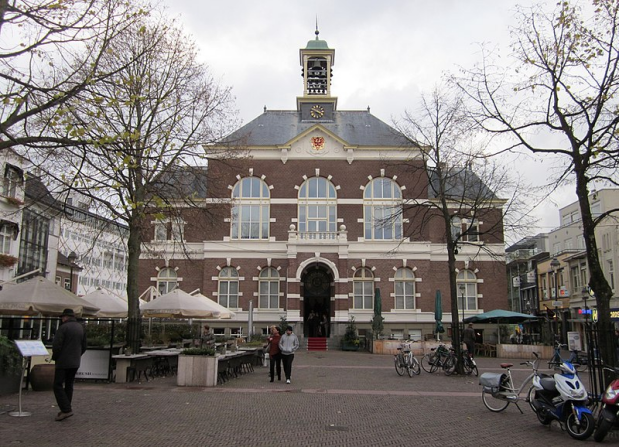
II Geography
Climate
Apeldoorn experiences an oceanic climate (Köppen climate classification Cfb) similar to almost all of the Netherlands.
Transport
There are four railway stations in Apeldoorn, these are:
Apeldoorn
Apeldoorn De Maten
Apeldoorn Osseveld
Klarenbeek
Apeldoorn
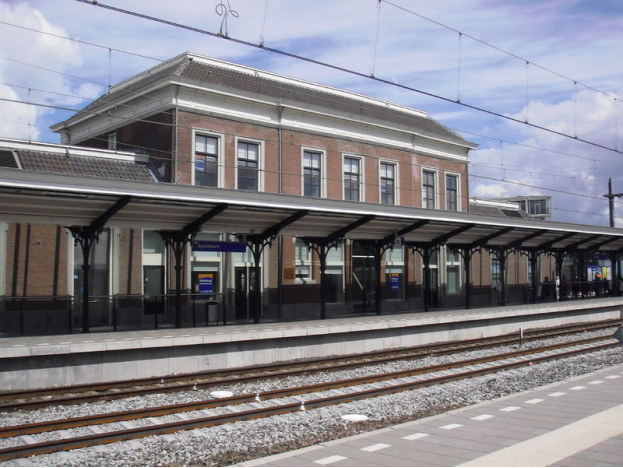
Apeldoorn railway station in 2010
Location Stationsplein 8, Apeldoorn, Gelderland, Netherlands
Coordinates 52°12′33″N 5°58′10″E
Operated by NS Stations
Line(s)
Amsterdam–Zutphen railway
Apeldoorn–Deventer railway
Apeldoorn–Dieren railway
Platforms 4
Tracks 8
Train operators Arriva
Nederlandse Spoorwegen
NS International
Bus operators Breng
Syntus
Apeldoorn railway station is a railway station in Apeldoorn in Gelderland, Netherlands. The station was opened on 15 May 1876, on the Amsterdam–Zutphen railway. It was opened when the Amersfoort to Zutphen section was completed. Journey time to Amsterdam is 1 hour, as of the 2017 timetable.
Location
The railway station is located at the Stationsplein (English: Station's Square) in the town center of Apeldoorn in the province of Gelderland in the middle of the Netherlands. It is situated on the Amsterdam–Zutphen railway between the railway stations of Hoevelaken in the west and Apeldoorn De Maten in the east. It is also the western terminus of the Apeldoorn–Deventer railway before Apeldoorn Osseveld in the east and the northern terminus of the Apeldoorn–Dieren railway before Beekbergen in the south.
History
The railway station was opened on 15 May 1876.
In 1887 there were local lines from Apeldoorn in three directions:
Apeldoorn–Zwolle railway (dismantled)
Apeldoorn–Dieren railway (now property of the VSM Steam Railway)
Apeldoorn–Deventer railway in use since 1887.
The station building was saved in connection with a massive refurbishment of the station from 2004 to 2008.
Services
Trains
As of April 2017, the following train services call at this station:
Express services:
Intercity: Amsterdam - Amersfoort - Deventer - Hengelo - Osnabrück - Hanover - Berlin
Intercity: Schiphol - Amersfoort - Deventer - Hengelo - Enschede
Intercity: The Hague/Rotterdam - Utrecht - Amersfoort - Deventer - Hengelo - Enschede
Intercity: Amsterdam - Amersfoort (- Deventer)
Local services:
Sprinter: Apeldoorn - Deventer - Almelo (- Hengelo - Enschede)
Stoptrein: Apeldoorn - Zutphen
From 9 December 2012, Arriva operates the train between Apeldoorn and Zutphen. From the same date Apeldoorn no longer had a direct connection with Rotterdam on weekdays; a change of trains was required in Amersfoort or Utrecht. In the 2015 timetable, however, the direct connection to Rotterdam on weekdays has been restored by splitting/combining trains in Utrecht. The intercity Amsterdam - Deventer calls at Apeldoorn every hour during weekdays and twice an hour during peak hours, however, not at the times the intercity Amsterdam - Berlin calls at Apeldoorn.
From 11 December 2016, the local Sprinter service to Almelo is only extended towards Enschede during weekday peak hours, where it used to be all day until 20:00 during weekdays. This change was implemented as a result of regional subsidies from the local Twente government being revoked, and led to strong protests from commuters and especially students at university and high schools in Enschede.
Buses
There is a large bus station next to the station. From here town and regional bus services operate. These buses are operated by Syntus, with certain journeys on service 43 operated by Breng. All bus services are frequent and connect with train services.
Apeldoorn De Maten
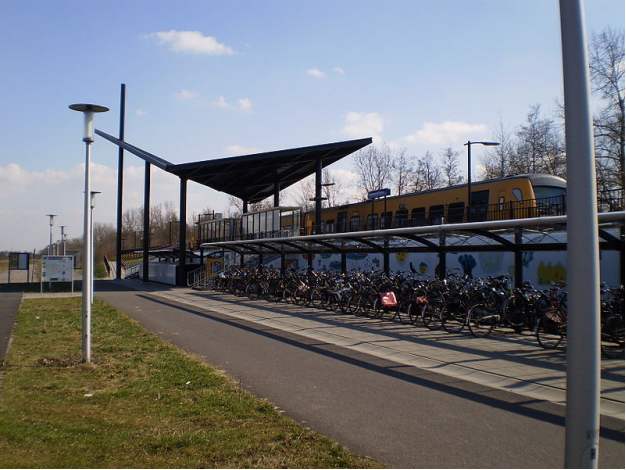
Station Apeldoorn De Maten
Coordinates 52°12′N 6°00′E
Line(s) Amsterdam–Zutphen railway
Platforms 1
Tracks 1
History Opened 10 December 2006
Apeldoorn De Maten is a railway station located in Apeldoorn, Netherlands. The station was opened on 10 December 2006 and is located on the Amsterdam–Zutphen railway between Apeldoorn and Zutphen. The services are operated by Arriva.
Train services
The following services currently call at Apeldoorn De Maten:
2x per hour local services (stoptrein) Apeldoorn - Zutphen
Bus connections
The following bus services also stop near the station.
3 Station - Town Centre - Zutphensestraat - Station De Maten - Matenhoeve - Matenveld
4 Station - Town Centre - Zutphensestraat - Station De Maten - Matenveld - Matenhoeve
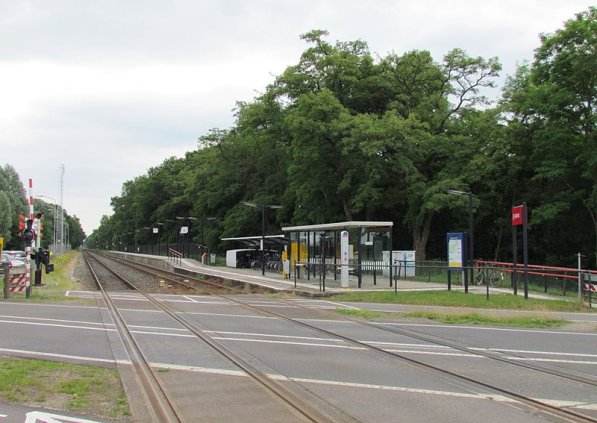
The bus network of Apeldoorn town services
Apeldoorn Osseveld
Coordinates 52°12′56″N 6°00′18″E
Line(s) Apeldoorn–Deventer railway
Platforms 2
Tracks 2
History Opened 10 December 2006
Apeldoorn Osseveld is a railway station located in Apeldoorn, Netherlands. The station was opened on 10 December 2006 and is located on the Apeldoorn–Deventer railway. The services is operated by Nederlandse Spoorwegen.
Train services
As of 11 December 2016, the following train services call at this station:
Local Sprinter service: Apeldoorn - Deventer - Almelo (- Hengelo - Enschede)
This service continues towards Enschede during weekday peak hours only.
Klarenbeek
Location Netherlands
Coordinates 52°10′40″N 6°5′3″E
Line(s) Amsterdam–Zutphen railway
History Opened 1882
Klarenbeek is a railway station, located in Klarenbeek, Netherlands. The station opened on 1 June 1882 and is on the Amsterdam–Zutphen railway (Oosterspoorweg). The station is actually 2 km north-east of Klarenbeek. The station was originally only built because the line between Apeldoorn and Zutphen was single track, a passing point was needed, this was here. Until December 2006, the station had just 1 platform and one train each way per hour stopped at the station, allowing the other to pass. In December 2006, when 2 more new stations were built on the line, the station received 2 platforms. The train services are operated by Arriva.
Tourism
The station is the beginning point for many walks in the area, many people start their journey at the station to see the famous country-side. The Dutch Railways offers many walks in this area via their magazine which is sent to all their customers around The Netherlands.
Train service
The following services call at Klarenbeek:
2x per hour local services (stoptrein) Apeldoorn – Zutphen
Bus service
508 Klarenbeek Station – Klarenbeek – Klein Amsterdam – Empe – Voorst-Empe Station operates 1x per hour (Monday to Saturday) and is operated by Syntus.
III Economy
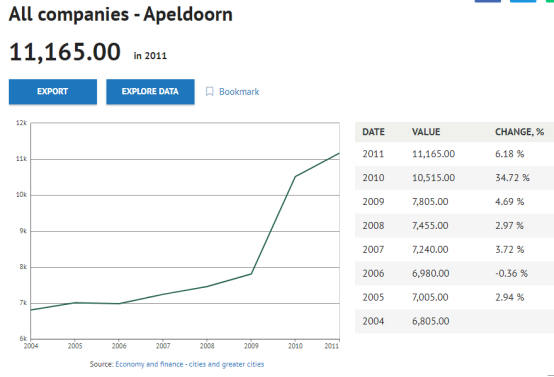
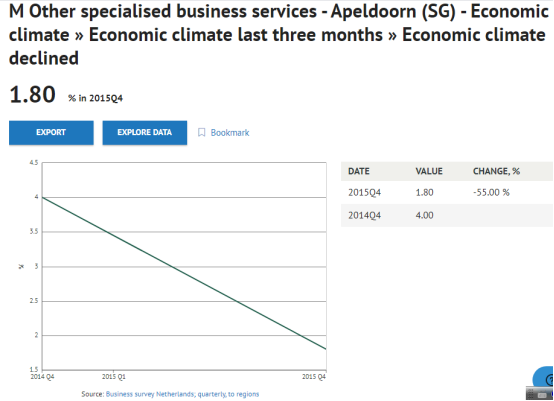
Reference: https://knoema.com/search?query=apeldoorn%20gdp
Apeldoorn has also now a considerable meat processing industry with production and storage facilities of among others; Vion, Van Drie Group (ESA, Ekro), Grolleman Groep (cold stores, transport and meat processing), Amsterdam Meat Company (Ameco), other big/larger companies or ones that are of local importance are, among others; Hanos international (horesca), Hamer B.V. (installation), HSL Locistics but this will be as of January 2018 merged with GVT Logistics, Sandd (postal services), HCA Holland Colours (industrial plastics coloring), Remeha (heating boilers), Royal Reesink N.V., UPS, DHL, FedEx, Royal Talens (artist materials manufacturers and suppliers), VDL Weweler (international bus and truck parts manufacturing company), I.T.S. BV., Beekman transport, Kisjes transport and container rental.
Apeldoorn is also known for its (historical) large number of used car dealers.
Apeldoorn had until a few years ago a production facility that produced basic materials for medicine production operated by Akzo Diosynth, but production was seized here, and the terrain located at the Vlijtseweg is now renamed after the product that was produced here before that, Zwitsal, it is now known as “Zwitsal Apeldoorn” and the former facility now houses many new local businesses such as the beer brewery “De Vlijt”.
IV Industrial Projects
Establishing rules for Groot Zonnehoeve soil energy
The municipality of Apeldoorn also opts for sustainability and opts for gas-free construction. Soil energy is applied on a large scale in the Groot Zonnehoeve district. In most cases, homes are heated by soil energy systems (soil heat exchangers). A soil energy plan has been drawn up for the Groot Zonnehoeve district to ensure that the systems do not influence each other and that sufficient heat can be extracted from the soil. In this plan, usage rules have been elaborated, so that new closed soil energy systems in this district can be better tested.
Soil energy systems influence each other
If there are many soil energy systems on a limited surface, the soil will cool down too much. As a result, a soil energy system becomes less effective: the heat pump then needs more energy. New homes are still being built in the Groot Zonnehoeve district. Due to an increase in the number of soil energy systems, the chance of mutual influence is increasing.
Apply soil energy plan
That is why a soil energy plan has been drawn up for the Groot Zonnehoeve district . This contains rules of use, so that the energy budget per lot can be distributed evenly. In this way, we can guarantee the proper functioning of all soil energy systems in this district in the long term and sufficient soil heat can be supplied. To be able to impose these rules of use, the Groot Zonnehoeve district must be designated as an interference area in the municipal bye-law. This soil energy plan is currently available for inspection .
Obligation to license new systems
By determining the interference area Groot Zonnehoeve, all soil energy systems in this district fall under the permit requirement. Because it is a regular procedure, the handling time is a maximum of eight weeks. The advantage of the rules of use is that installers of soil energy systems no longer have to make extensive calculations. In the application they make clear that the usage rules are applied.
Large Sun Farm
Villahoeve in the Groot Zonnehoeve district has grown considerably in recent years to a beautiful residential area. In October we want to start with the last step: making it ready for living. This means that we will be laying out the final pavement and the greenery, so that the neighborhood is really finished and nice to live in.
Because there is still a lot of work going on at the moment, we are going to carry out the preparation in stages. In phase 1 we tackle the street Wezel and parts of the streets Boommarter and Steenmarter. Phase 2 will start in the spring of 2021, then we will work in the remaining parts of the streets Boommarter and Steenmarter. Finally, we will finish in the second half of 2021 with the Laan van Zonnehoeve and Barnewinkel.
The work mainly consists of laying paving, including thresholds and entrances, finishing roadsides and planting trees.
Reference: https://www.apeldoorn.nl
V House of Orange-Nassau
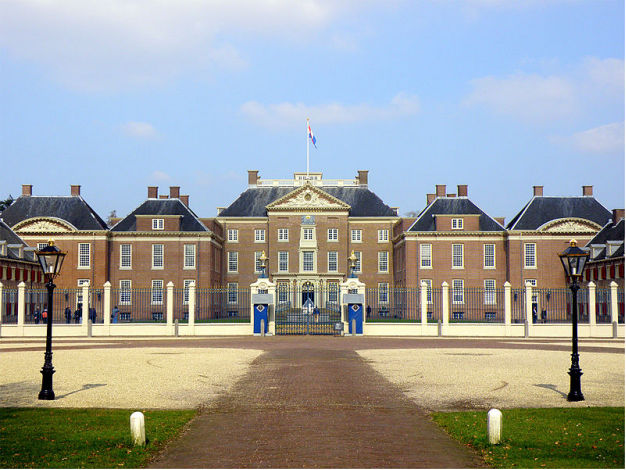
Paleis Het Loo, spring 2012
House of Orange-Nassau
Paleis Het Loo reflects the historical ties between the House of Orange-Nassau and the Netherlands. The central part of the palace and the lateral pavilions show how the palace was inhabited by the House of Orange for three centuries starting with the King Stadtholder William III of England up to and including Queen Wilhelmina.
In November 1684 Prince William III of Orange, then Stadtholder of Gelderland, purchased Het Loo with the intentions of building a palatial hunting lodge somewhere on the property. On April 5, 1685, the first contract was tendered and in September of the same year the stonework of the middle section (or corps de logis) of what came to be known as Het Loo was completed. In 1686, the year given on the facade of the building, the wings, originally linked by colonnades to the corps de logis were added, the walls were built and the gardens were laid out.
Het Loo became the favorite hunting seat and country palace of William III and his wife Princess Mary II, and until his death in 1702 furnishings and decorations both inside and outside underwent repeated alterations and embellishments. At that time symmetry was considered ideal and the design for the building and grounds featured a central axis with mirror image components on either side. Inside the palace the axis consisted of the Entrance Hall, the Staircase and the Great Hall on the first floor. West and east of the Great Hall respectively were the apartments of William III and Mary II. The apartments of the courtiers and the Dining Room were on the ground floor.
In 1689 William III became King of England, Scotland and Ireland and this elevation of his position and power brought an enlargement of Het Loo in its wake. Between 1691 and 1694 the colonnades which linked the corps de logis to the wings on either side were replaced by four pavilions. These pavilions contained the new apartments of William III and Mary II, a new Dining Room, a Long Gallery and a Chapel. Queen Mary did not return to the Netherlands after 1689 and never saw the enlargement.
On the death of King William III in 1702 there was disagreement about his inheritance, but eventually, in 1732, Het Loo descended to Willem IV (1711–1751) who was, from 1747, Stadtholder of all the provinces. Both Willem IV and his son Willem V (1748–1806) used the palace in the 18th century as a summer residence.
The "Apenheul", a zoo specialising in monkeys and great apes. Some of the species are free to roam amongst the visitors, and the design of the park is renown for its excellent animal habitats.
For Architecture/urban enthusiasts, the original Structuralist "Centraal Beheer" building by Herman Herzberger is located 5minutes walk west from the central train station. Just a little further down the road, a more recent project of his has been realised ("De witte wolken"), and may be interesting for comparison. Yet further still, and slightly to the north, the large "Walterboschcomplex" tax offices (by acclaimed architects Neutelings-Riedijk) can be viewed, representing some of the Netherlands' finest modern office architecture.
VI Apeldoorn - a Rich History
The history of Apeldoorn goes back to the year 792, when the "villa ut marca Appoldro" was mentioned in a deed of gift. At the time the "city" only consisted of few houses, it has grown to a thriving city over the centuries.
At the end of the 16th century, when the paper industry began to flourish, Apeldoorn began to grow. In 1684 Willem III van Oranje (the ancestor of the Dutch Royal family) bought house Het Loo and build palace Het Loo in Apeldoorn. Several members of the Royal family have lived there over the centuries, which gave the city its still present charm and charisma.
During the 20th century Apeldoorn has grown into one of the larger cities in the Netherlands, measuring 340 km2.
Compared to other towns and cities, Apeldoorn is surprisingly different. The beautiful gardens, many city parks, impressive detached dwellings and relatively few high-rise buildings, give it an atmosphere of tranquillity and space.
The fairly large rural area around the centre that is home to villages such as Hoenderloo, Beekbergen/Lieren, Loenen, Oosterhuizen, Klarenbeek, Wenum-Wiesel, Beemte Broekland, Uddel, Hoog Soeren, Radio Kootwijk and Ugchelen, strongly enhances the atmosphere.
Apeldoorn is located in the centre of Netherlands, in the province of Gelderland. It's situated along National Park the Veluwe, with western parts of the city spread over forest covered hills dotted with small lakes, and eastern parts stretching into a wooded valley.
Referernce: https://www.wittenborg.eu/apeldoorn-rich-history.htm
VII OTHERS
Smart City Apeldoorn
Technology as a means of contributing to issues
Technology can also be used as a solution for a number of issues. This could include:
Combining traffic data with air quality data to make possible other choices in traffic flow, which improves air quality.
Indicate free parking spaces for car and bicycle.
Sensors that indicate whether trees and plants are receiving enough water.
Smartly linking traffic lights to the rain radar of the KNMI, giving cyclists priority in (upcoming) bad weather.
Sound sensors in Apeldoorn that measure different types of noise. Consider, for example, the noise from aircraft, but also identify possible noise from highways and roads.
Sensors that report whether a tunnel is under water
Sport
Until early 2013, Apeldoorn housed the professional football club AGOVV Apeldoorn (Eerste Divisie), that played its matches in the Sportpark Berg & Bos stadium in the western part of Apeldoorn. However, AGOVV was forced to declare bankruptcy on January 10, 2013, because of an €400,000 tax debt. In 1958 the AGOVV stadium was used to promote Dutch Rugby Football, by staging a match between an English touring XV Thomas Cook's Rugby Club and RC Hilversum in front of 2,671 spectators. It was a 3 points draw. See film clip of first overseas tour to Holland 1958 The present rugby club, Rams RFC, was founded in December 1971.
The most successful club in Apeldoorn is the SV Dynamo volleyball team, who are the 12-fold champion in the Dutch A-League, most recently in 2010. Another successful volleyball club in Apeldoorn, and a big competitor to Dynamo, is Alterno.
Because of the growth of Apeldoorn, and the population's interest in sports, Apeldoorn has built a new stadium for volleyball, indoor athletics and track cycling. The stadium, Omnisport Apeldoorn, opened in 2008 and has hosted the 2011 UCI Track Cycling World Championships and the European Track Championships in 2011 and 2013. In 2016 the city hosted the opening time-trial stage of the Giro d'Italia.
The southwestern corner of the municipality is part of the Hoge Veluwe National Park. It is the final Battle Honour of The Royal Canadian Regiment who took part in the town's liberation in World War II.
VIII CONTACT
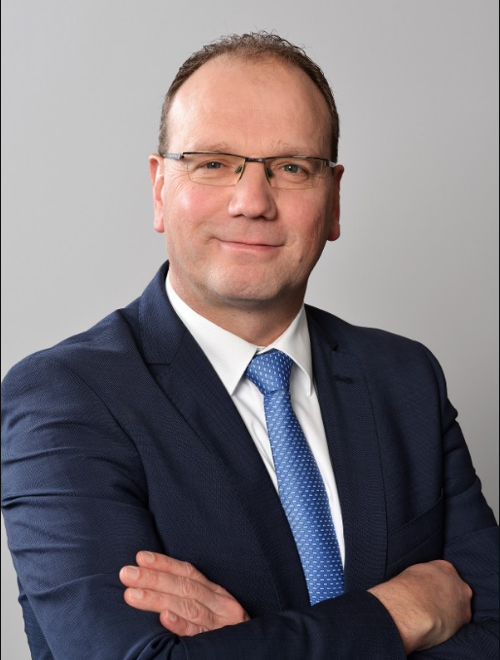
Mayor: Ton Heerts
Born: December 12, 1966 (age 53 years), Tubbergen, Netherlands
Education: Koninklijke Militaire Academie (1989), Pius X College Aalderinkshoek (1985)
Twitter:
Ton Heerts
@heerts
Visiting address
Marktplein 1, 7311 LG Apeldoorn
Telephone: 14 055 (no area code needed)
From abroad: +31 55 580 15 55
Email address: gemeente@apeldoorn.nl
Postal address:
Gemeente Apeldoorn
Postbus 9033, 7300 ES Apeldoorn
Social Media
Twitter @gem_apeldoorn
Facebook gemeente Apeldoorn
Press
Journalists can contact gemeente Apeldoorn through the following e-mail address and phone number:
pers@apeldoorn.nl
+31 (0)55 580 13 63
